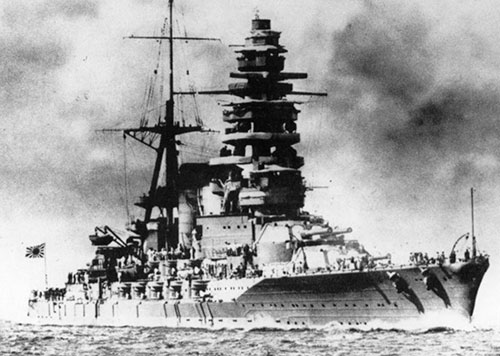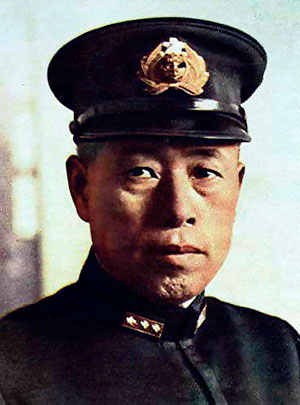Climb Mount Niitaka

(His Imperial Japanese Majesty’s Ship Nagato. Photo USN).
On 26 November, 1941, the Combined Fleet and its Kidō Butai (also known as the Carrier Striking Task Force) set sail from Hittokapu Bay in Japan’s Kurile Islands under the overall command of Admiral Isoroku Yamamoto. He had personally selected the battleship Nagato as his flagship, the proud ship to lead the mightiest naval force ever to steam the Pacific Ocean.
Nagato had a bold look that Yamamoto appreciated, and she rode well as she sliced the waves at her best speed of twenty-six knots. She and her sister ship Mutsu had been built as Dreadnaught-class warships of 38,000 tons burden, 708 feet in length and nearly a hundred on the beam. Both had been extensively refitted with a unique seven-legged mast designed to maximize rigidity for range-finding purposes and survivability under shellfire.
The unique superstructure recalled the design of a pagoda, and consisted of a thick vertical leg in the center surrounded by six outer legs. The central leg was large enough to accommodate an electric elevator running between the foretop and main deck that carried the Admiral to his post on the flag bridge.
As peace talks continued in Washington, the ships made an undetected transit of the North Pacific to be in position for the contingency of war.
Peace was still a possibility. Yamamoto, a graduate of the US Naval War College and Harvard University, was confident that his bold plan to conduct a devastating surprise attack could secure an early advantage in a conflict against the United States. He was a realist, though, and knew that such advantage could not be guaranteed beyond the first year of war. He hoped for peace.
It did not come. Talks in Washington broke down. Admiral Yamamoto was directed to carry out his plan. On 2 December, the radio room in Nagato transmitted a message to the commander of the Kido Butai, Vice Admiral Chuichi Nagumo. The final decision had been made in Tokyo. It was to be war.
Yamamoto directed Nagato’s radio room to send a message to the carrier striking force. The large vacuum tubes glowed orange with the power of the transmitter:
“NIITAKA-YAMA NOBORE 12 08” (新高山登れ12 08?). “Climb Mount Niitaka, 1208.
Admiral looked at the message from Yamamoto and looked at his chief of staff: “Hostilities will begin on December 7th, exactly as scheduled.”
By the morning of December 7, from a position some 200 miles north of Oahu, six Japanese carriers began to launch the first attack wave. At 0753hrs, strike leader Commander Mitsuo Fuchida sent the signal “Tora! Tora1 Tora!” indicating that the “lightning strike” on Pearl Harbor had achieved the element of surprise.
A staff officer raced the message from the Nagato’s radio room to the Flag Bridge and handed the message to Admiral Yamamoto. The admiral nodded gravely. Now it was begun. It would be anyone’s guess where and how it might end.

(Admiral Isoroku Yamamoto. Photo USN).
Copyright 2015 Vic Socotra
www.vicsocotra.com
Twitter: @jayare303
Editor’s note: sure this is all out of chronological order but the book- at least this version- is done. I will be sending it out as an e-book in the morning. Stand by!
